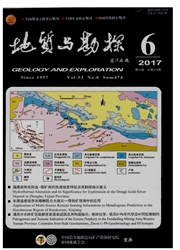

 中文摘要:
中文摘要:
那茶淌北铅锌矿床位于西藏冈底斯成矿带东段北部,主要由矽卡岩铅锌矿体组成,是一个典型的矽卡岩型矿床。笔者通过对矿床内的矽卡岩、大理岩(灰岩)、黑云母花岗岩的地球化学对比分析表明:在主量元素方面,显示Si、Al、Fe、Ti、Mg、Ca、Mn等元素在矽卡岩、大理岩、黑云母花岗岩之间发生明显的交换;在稀土元素方面,矽卡岩、大理岩和黑云母花岗岩均具有LREE富集,HREE亏损,并且发育Eu和Ce负异常和相似的REE配分模式,说明矽卡岩的成因与大理岩、黑云母花岗岩具有一定关系。结合三种不同岩性的地球化学特征,强烈的轻、重稀土分异,Eu、Ce负异常,推测矽卡岩由中高温还原热液交代碳酸盐而成,矽卡岩成岩过程中可能有少量海水加入。
 英文摘要:
英文摘要:
The Nachatangbei Pb-Zn deposit,located in the northern part of the eastern Gangdise meltallogenic belt,is composed of skarn and Pb-Zn ore bodies,thus being a typical skarn type deposit. The geochemical analysis of skarns,marble( limestone) and biotite granite in the deposit shows that there are obvious exchanges among Si,Al,Fe,Ti,Mg,Ca and Mn of these three rocks. For the rare earth elements,they have LREE enrichment,HREE loss,and the development of Eu and Ce negative anomalies and similar REE distribution patterns,indicating the causes of these rocks have a certain relationship. Combined with three different lithologic geochemical characteristics,strong light and heavy rare earth element differentiations,and negative Eu and Ce anomalies,this study suggests that the skarns came from the high temperature reduction hydrothermal metasomeric carbonate,and during its formation the fluid might have a small amount of seawater added.
 同期刊论文项目
同期刊论文项目
 同项目期刊论文
同项目期刊论文
 期刊信息
期刊信息
